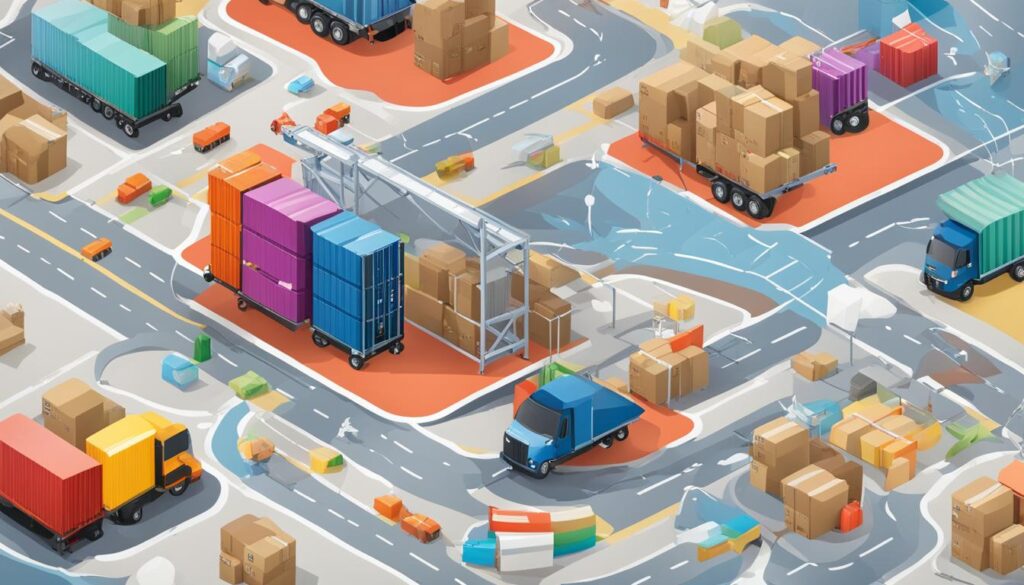Free shipping is a major factor in online purchasing, with a majority of shoppers expecting fast and free shipping. Many retailers offer free shipping as a way to streamline checkout and encourage more customers to make a purchase. However, setting a free shipping threshold is crucial to balance the costs and benefits.
According to surveys, consumers expect to spend between $20 to $50 to qualify for free shipping, and lackluster shipping options are the top reason for cart abandonment. It is essential for retailers to find the right balance between maintaining profit margins and satisfying customer expectations.
Key Takeaways:
- Free shipping is a significant factor in online purchasing.
- Setting a free shipping threshold helps balance costs and benefits.
- Consumers expect to spend $20 to $50 to qualify for free shipping.
- Lackluster shipping options can lead to cart abandonment.
- Find the right balance between profit margins and customer expectations.
What is Ecommerce Free Shipping?
Ecommerce free shipping is a powerful tool used by online retailers to attract and retain customers. It refers to the practice of shipping purchased goods to customers without charging any additional shipping fees. This offering has become a key competitive advantage in the world of online businesses, as customers increasingly expect fast and free shipping as a standard part of their shopping experience.
To qualify for ecommerce free shipping, customers often need to meet certain conditions set by the retailer. These conditions can include reaching a minimum order value, subscribing to an email newsletter, or being a part of a loyalty program. By implementing these requirements, retailers can ensure that the costs of free shipping are mitigated and their profit margins remain intact. At the same time, it allows customers to enjoy the benefits of a seamless and satisfying shopping experience.
Online retailers have recognized the significant impact of offering free shipping to their customers. It not only provides a tangible incentive for customers to choose online shopping over brick-and-mortar stores but also helps build brand loyalty and increase customer satisfaction. By strategically employing the concept of ecommerce free shipping, retailers can attract more customers to their websites and encourage them to make larger purchases, thus contributing to higher sales and business growth.
Strategies for Offering Free Shipping
When it comes to offering free shipping, retailers can employ various strategies to ensure they are not losing money. These strategies involve clever tactics that help offset the costs associated with providing free shipping to customers.
Increase Product Prices
One approach retailers can take is to increase product prices slightly to cover the cost of shipping. By doing so, the impact of offering free shipping is absorbed into the overall price of the product. This allows retailers to maintain profit margins while still providing a desirable shipping experience to customers.
Supply from Lower Shipping Cost Regions
Another strategy is to source products from regions with lower shipping costs. This allows retailers to minimize the expenses associated with shipping and pass on those savings to customers. By strategically selecting suppliers from regions where shipping costs are lower, retailers can offer free shipping without compromising their bottom line.
Increase Customer Lifetime Value
Increasing customer lifetime value is another effective strategy for offsetting the costs of free shipping. By implementing loyalty programs, personalized recommendations, and targeted marketing campaigns, retailers can encourage repeat purchases and increase the overall value of each customer. Loyal customers are more likely to justify the expenses associated with free shipping, making it a worthwhile investment for retailers.
Offer Bundles
Offering product bundles is yet another strategy that can help retailers offset the costs of free shipping. By encouraging customers to add more items to their cart, retailers can increase the average order value, which in turn lowers the shipping costs per item. Bundling complementary products not only drives customer satisfaction but also enables retailers to offer free shipping without compromising their profitability.
By employing these strategies, retailers can effectively offer free shipping to their customers while maintaining profitability. From increasing product prices to sourcing from lower shipping cost regions, these tactics enable retailers to enhance customer satisfaction and increase customer lifetime value, all the while meeting the expectations of today’s online shoppers.
“Offering free shipping is a powerful strategy that can greatly impact customer behavior and drive sales. By implementing these strategies, retailers can find the right balance between cost and benefit, ultimately creating a positive shopping experience for their customers.”

| Strategies | Description |
|---|---|
| Increase Product Prices | Adjusting prices to include shipping costs |
| Supply from Lower Shipping Cost Regions | Sourcing products from regions with lower shipping costs |
| Increase Customer Lifetime Value | Implementing loyalty programs and personalized marketing to drive repeat purchases |
| Offer Bundles | Creating product bundles to increase average order value and lower shipping costs per item |
Determining the Free Shipping Threshold
The free shipping minimum threshold is the lowest price at which retailers are willing to offer free shipping. When determining this threshold, several factors should be considered, including shipping costs, average order value (AOV), and customer preferences. By analyzing these factors, retailers can strike the right balance between profitability and customer satisfaction.
Factors to Consider
Average Order Value (AOV): Retailers can calculate the AOV by adding up the total order values and dividing them by the number of transactions. This metric helps determine the average amount customers spend per order. A higher AOV may allow for a lower free shipping threshold, as customers are already spending more.
Median Order Value (MOV): Another useful metric to consider is the median order value, which represents the midpoint of the order values. Calculating the MOV can provide insight into the typical spending behavior of customers. This information can help retailers determine an appropriate free shipping threshold.
Profit Margins: Retailers must also consider their profit margins when setting the free shipping threshold. It’s important to strike a balance between offering free shipping and maintaining profitability. Analyzing profit margins can help retailers avoid potential losses associated with free shipping.
Optimizing the Free Shipping Threshold
To optimize the free shipping threshold, retailers can analyze the relationship between AOV, MOV, and shipping costs. By finding the sweet spot where customers feel incentivized to spend more while still covering shipping expenses, retailers can maximize both customer satisfaction and profitability. Additionally, conducting A/B testing with different free shipping thresholds can help retailers determine the most effective approach for their specific customer base.
“The right free shipping threshold can have a significant impact on customer behavior and can contribute to increased sales and customer loyalty.”
By considering factors such as AOV, MOV, and profit margins, retailers can determine an appropriate free shipping minimum threshold. This threshold can encourage customers to spend more, increase average order values, and improve customer satisfaction. Striking the right balance between profitability and customer expectations is crucial for online retailers to effectively leverage the power of free shipping.

How does the Free Shipping Threshold impact impulse buying behavior?
The Free Shipping Threshold can significantly influence the phases of impulse buying insight. When customers are close to reaching the free shipping minimum, they may be more likely to make additional purchases in order to qualify, ultimately impacting their impulse buying behavior.
Conclusion
Free shipping is a key factor in influencing customer purchasing decisions and can have a significant impact on sales and customer behavior. However, it is crucial for retailers to set a free shipping threshold that strikes a balance between the costs and benefits. By implementing effective strategies such as increasing the average order value and offering product bundles, retailers can not only provide a positive customer experience but also increase customer satisfaction and meet their expectations.
Furthermore, in order to succeed in the competitive online marketplace, retailers must prioritize customer satisfaction by offering a range of shipping options that cater to different preferences and needs. Clear communication about delivery expectations and transparent handling of any delays are also vital in building trust and loyalty with customers.
In conclusion, meeting customer expectations in terms of free shipping, customer experience, and shipping options is crucial for the success of an ecommerce business. By continuously adapting and refining shipping strategies, retailers can ensure they remain competitive and deliver a seamless and satisfying shopping experience to their customers.
FAQ
What is free shipping?
Free shipping is when online retailers send purchased goods to customers without charging shipping fees.
Why do retailers offer free shipping?
Retailers offer free shipping as a way to streamline checkout and encourage more customers to make a purchase.
How can customers qualify for free shipping?
Customers may need to reach a minimum order value, subscribe to an email newsletter, or be a part of a loyalty program to qualify for free shipping.
How can retailers offer free shipping without losing money?
Retailers can increase product prices to cover shipping costs, source products from regions with lower shipping costs, increase customer lifetime value, and offer product bundles.
How should retailers determine the free shipping threshold?
Retailers should consider factors such as average order value, median order value, and profit margins when setting the free shipping threshold.

